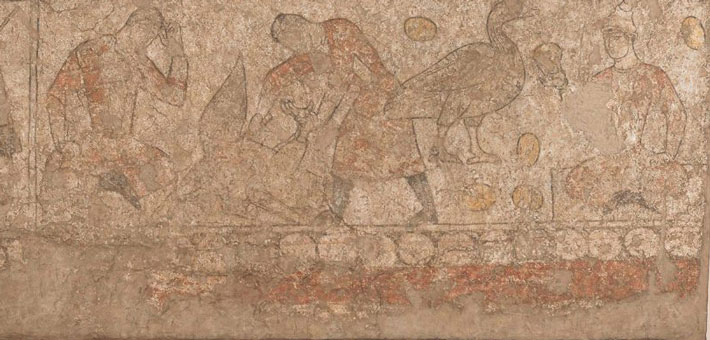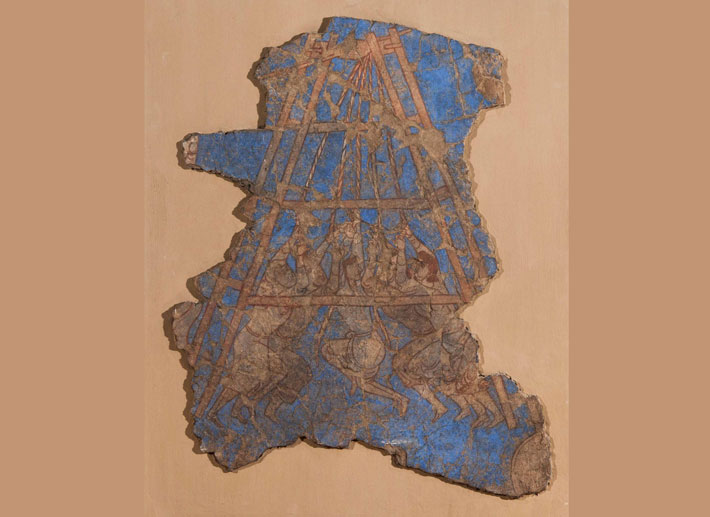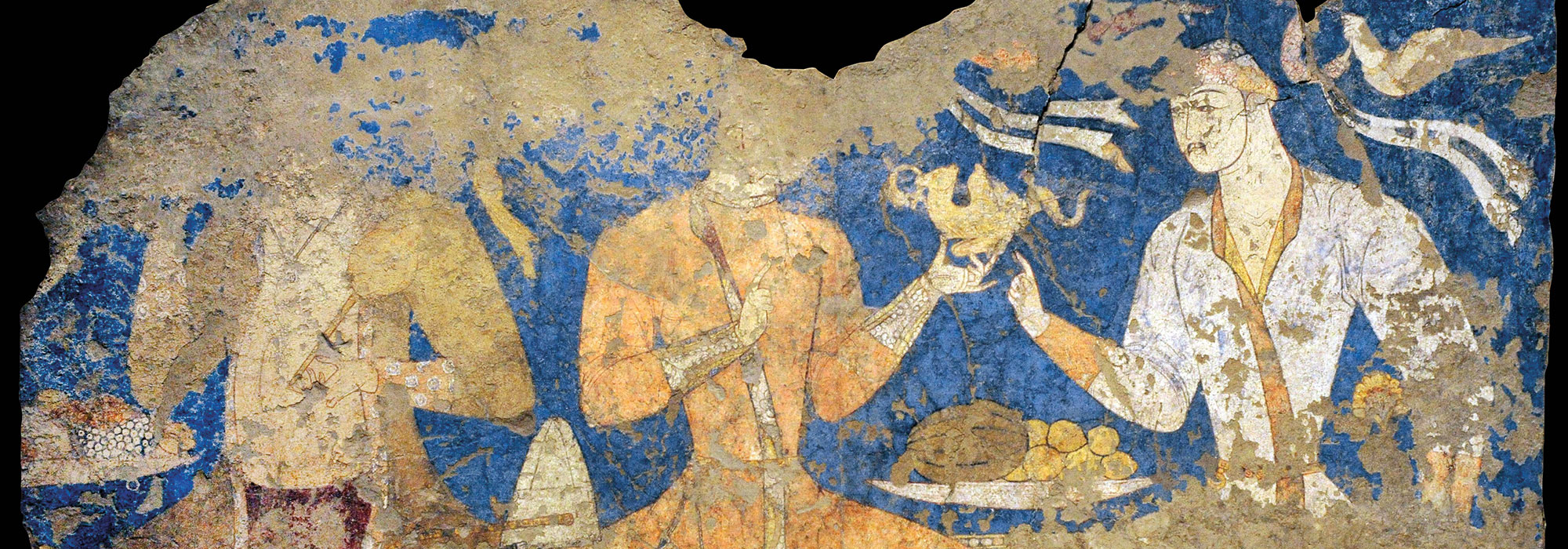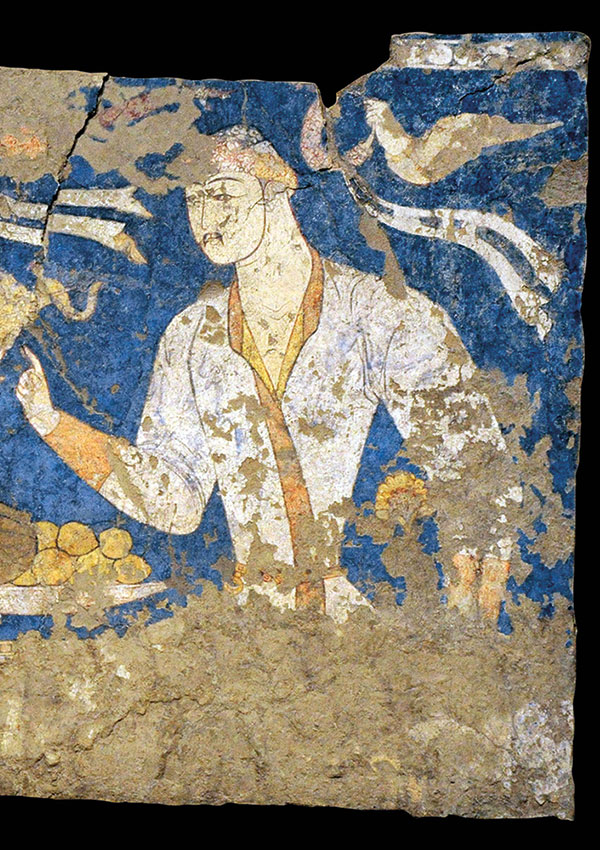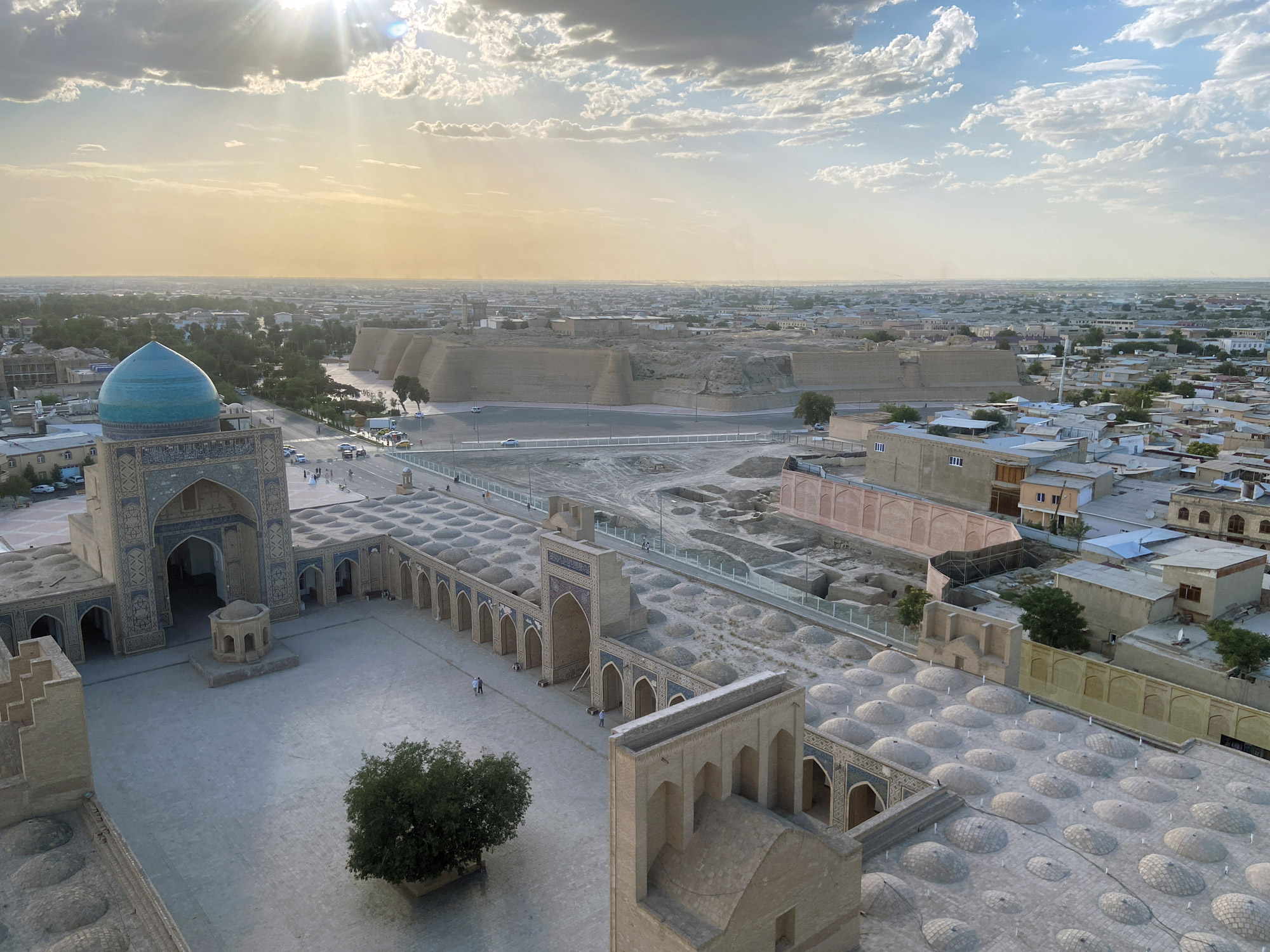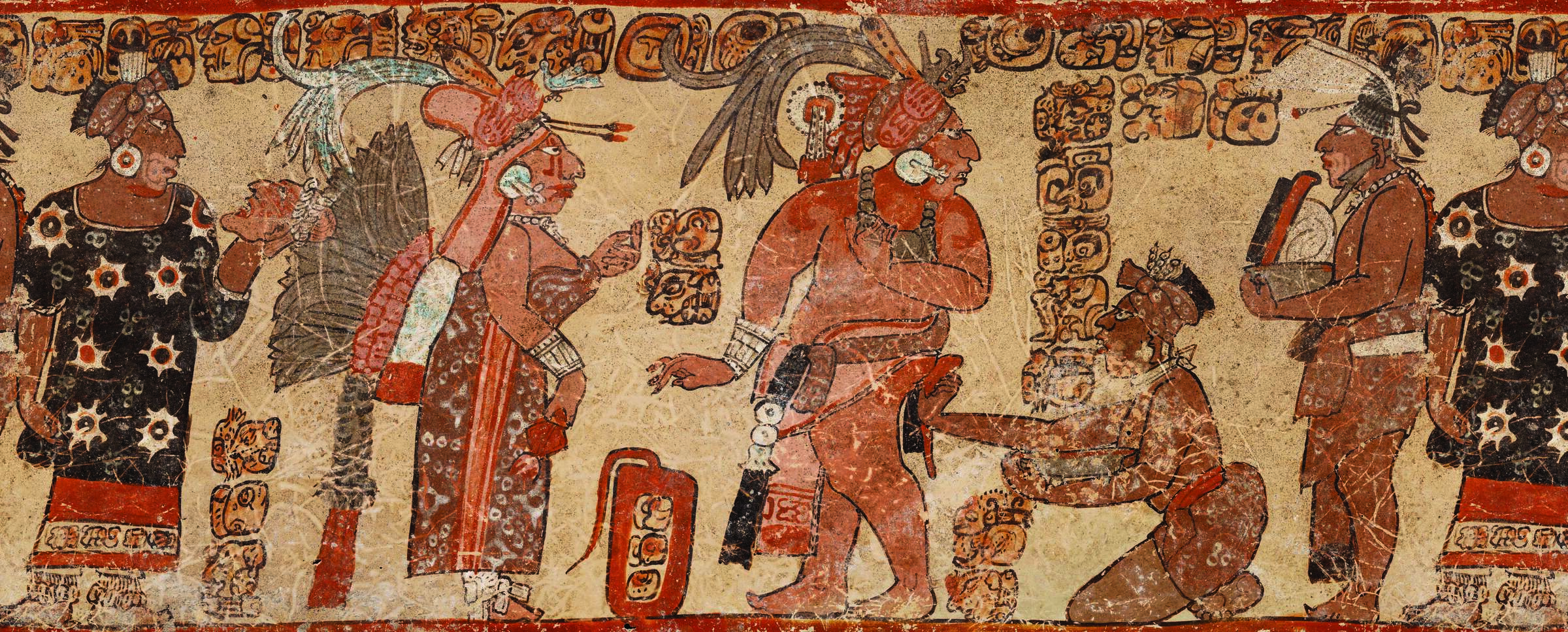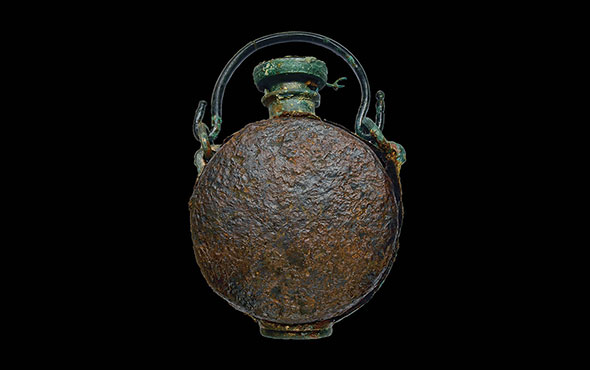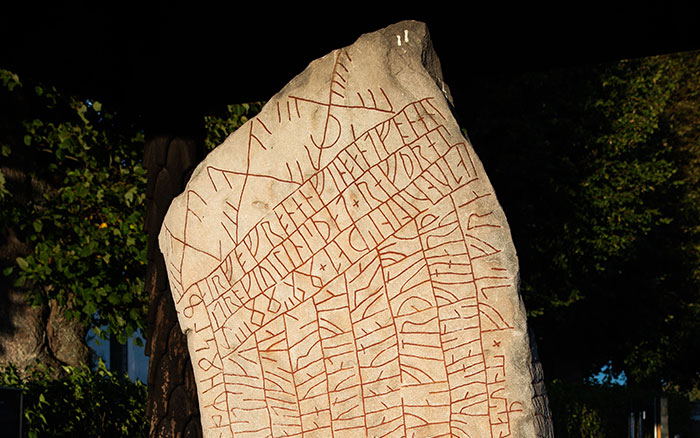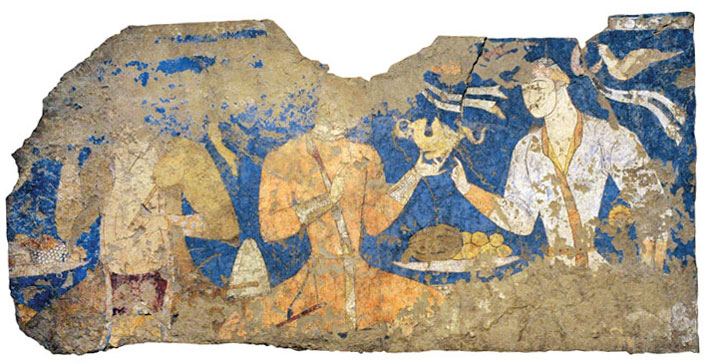
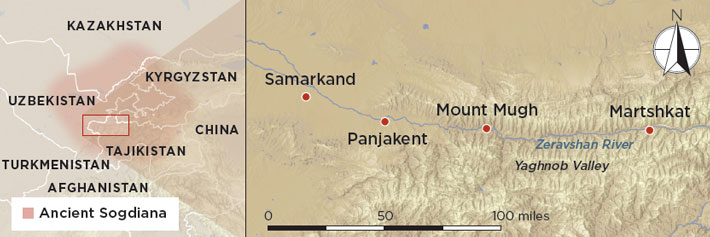
The Silk Road, the vast network of trade routes that connected China to the rest of Eurasia from roughly the first century B.C. to A.D. 1400, was justly famous in the West for the rich silk textiles it carried to the Mediterranean world. “But it could just as easily have been called the Jade Road, the Glass Road, or even the Rhubarb Road,” says art historian Judith Lerner of the Institute for the Study of the Ancient World at New York University. Such was the variety of commodities—raw silk, glass, spices, finished metalwork, ceramics, and much more—that any one of dozens of goods could have given the route its name. The Sacred Road, too, might once have been a fitting appellation. Christian and Buddhist missionaries, among others, used Silk Road caravans to cross the Asian continent. And from the fifth to the eighth century A.D., the overland trade routes that crossed through Central Asia might also have been called the Sogdian Road. An East Iranian people who lived in what is now Uzbekistan and Tajikistan, the Sogdians were, for a time, the leading merchants of the Silk Road. “The Sogdians achieved great influence via trade,” says Lerner. “The Chinese even had a saying: ‘When a Sogdian child is born, his mother puts honey on his tongue so that he will speak sweetly and glue on his palm so that money will stick to it.’”
The Sogdians were more than quick-witted intermediaries. At their height, their sophisticated culture, skilled diplomacy, and mercantile power helped shape the greater world around them. “You could describe the Sogdians as the first internationalists or globalists,” says Lerner. Sogdian diplomats, translators, artists, craftspeople, and entertainers traveled in the caravans that ventured along the Silk Road and settled in merchant colonies along the route in Central Asia and China. Sogdian was the lingua franca of the Silk Road, and, for a time, a vogue for all things Sogdian swept Tang Dynasty (A.D. 618–906) China. Chinese courtiers and concubines adopted Sogdian fashions, and the many Tang Dynasty depictions of Sogdian musicians suggest their performances were in high demand. For a time, a craze for an ecstatic dance known as the “Sogdian Whirl” swept the country, and Sogdian dancers became a popular motif in Chinese art that lasted long after Sogdians themselves had been assimilated. Indeed, in the mid-eighth century, a half-Sogdian general named An Lushan, who was reputed to weigh 400 pounds, was known for delighting the Chinese imperial court with his version of the Sogdian Whirl. In turn, the people of Sogdiana were highly receptive to outside ideas, religions, and artistic styles from China, India, and even the Byzantine Empire.
At home in Central Asia, the Sogdians lived in a number of independent city-states clustered around the Zeravshan Valley and the oases of modern-day Uzbekistan. “These states can be compared to the Italian city-states of the Renaissance, each with its own ruling family, laws, and government,” says Lerner. “In fact, the analogy can be taken further when we think of these cities’ rulers as ‘merchant princes’ since that is how the Sogdians derived their wealth.” Samarkand was one of the largest and most prosperous of these cities. Some 60 miles to the east, the much smaller city of Panjakent was a satellite of sorts to Samarkand, but supported its own vibrant economy.
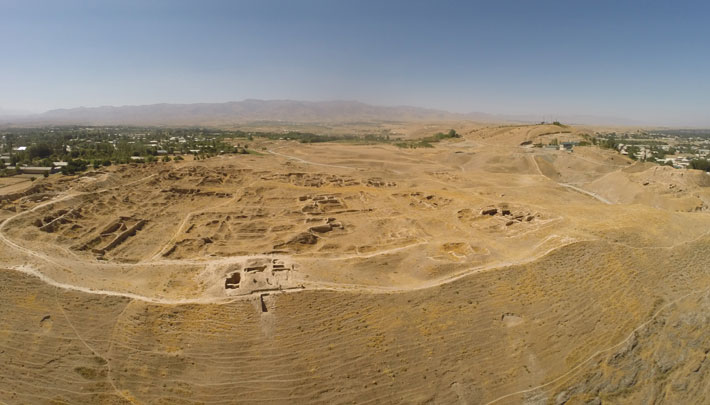
Today, the mudbrick ruins of Panjakent’s citadel, palaces, and temples survive behind formidable city walls that rise about three miles from the banks of the Zeravshan River in the present-day Sughd—itself the Sogdian word for Sogdiana—province of northern Tajikistan. For more than 70 years, excavations carried out there almost continuously by Soviet and then Russian and Tajik archaeologists have revealed the rich texture of Sogdian city life. Though several Sogdian cities have been excavated, much of what scholars know about Sogdiana is based on documents and artifacts recovered from towns along the Silk Road and in China. The excavations in Panjakent, now under the supervision of archaeologist and philologist Pavel Lurje of the State Hermitage Museum in St. Petersburg, offer a vivid glimpse of what the Sogdians were like in their homeland. In particular, dramatic murals depicting myths, fables, and everyday scenes characterize the world of the Sogdian imagination. “We find murals in almost every field season,” says Lurje. “It’s one of the reasons archaeologists have worked at the site for so many years.” Aleksandr Naymark, an archaeologist at Hofstra University who excavated at the site in the 1980s, says that the analogy of Sogdian merchants to Renaissance Italians is especially fitting given the dizzying array of murals that have been unearthed at Panjakent. “In northern Italy during the Renaissance you had this merchant class whose extreme wealth led to an exceptionally creative period, especially in narrative art,” says Naymark. “The Sogdian merchants enabled the same kind of burst of creativity, which you see in these murals.”

That world began to disappear in the eighth century. In 755, General An Lushan of Sogdian Whirl fame led a coup against the Chinese emperor that nearly succeeded. Its failure, however, heralded the end of Sogdian influence in China. At the same time, a slow-moving Arab invasion of Central Asia had already nearly erased Sogdiana from the map, and its inhabitants were soon largely forgotten. Lurje’s excavations at Panjakent and at a second, much more remote site known as Hisorak, offer a unique vantage point on Sogdian culture, both in its heyday and when it was close to vanishing.
In 1933, a Tajik herder walking down the slopes of Mount Mugh, some 40 miles east of Panjakent, found a mysterious clutch of papers in the ruins of a small mudbrick castle perched on the mountainside. Thinking the pages might be the remains of an old Koran, he took them to his village imam, who recognized that the text was not written in Arabic. In time, a Soviet district commissioner caught wind of the discovery, and archaeologists at the Academy of Sciences in what was then Leningrad were alerted. During their subsequent excavation of the small fortress, they discovered more than 80 Sogdian documents, which represented the royal archive of Devastich, the last Sogdian ruler of Panjakent.
By this time, Sogdian writing had been deciphered thanks to the discovery of similar caches along the Silk Road. Those papers record religious teachings, administrative and mercantile housekeeping details, and even private matters. One such cache, a group of letters discovered in 1909 at an ancient watchtower in China’s Gansu Province, includes correspondence from a Sogdian wife to her husband castigating him for abandoning her in China and detailing her cruel circumstances. The letter was never delivered. In another, a Sogdian merchant writing to his home office in Samarkand describes bloody incursions by nomads from the north. Believing that he wouldn’t survive the chaotic situation, he instructed his business partner to use money he had left in Samarkand to provide for his adopted son.
Devastich’s archive contains no such private letters, but it does contain voluminous correspondence with other Sogdian rulers and officials and with the Arab emirs then already ascendant in Samarkand and much of Sogdiana. The cache was secreted away in the castle on Mount Mugh when Devastich fled there, fearing capture by Arab forces. It didn’t prove to be an impregnable hideout. In 722, after an Arab army occupied Panjakent and burned many of its homes and temples, Devastich was captured and crucified.
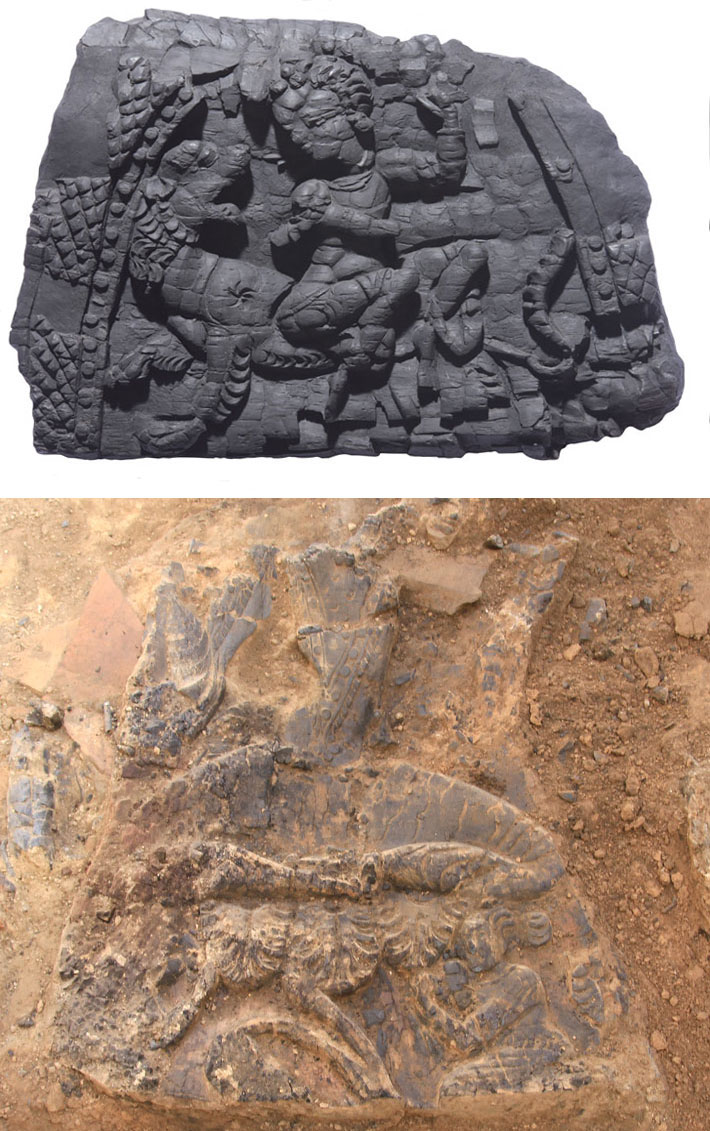
The discovery of such a spectacular collection of documents in Sogdiana, still the only such archive to have been found in the Sogdian homeland, prompted the Soviet archaeologists to turn their attention to Panjakent proper, where they began excavating in 1947. They discovered that a citadel had existed at the site from perhaps the second century B.C., but that the city itself dated to around the beginning of the fifth century A.D. when the residents of Panjakent erected a massive 30-foot wall, perhaps to protect it from nomadic incursions. Thereafter the city grew rapidly around carefully planned streets and lanes and became a densely occupied urban landscape, with two- and three-story buildings becoming the rule. “It’s a real mudbrick jungle,” says Lurje. “You have homes connected to shops that have separate entrances, but everything was quite close and people were living on top of one another.”
Since excavations began at Panjakent, archaeological teams have unearthed two temples. One may have been devoted to Adhvagh, the principal god worshipped by most Sogdians, who practiced the Mazdean faith, a form of Zoroastrianism. The second temple was the domain of Nana, the patron goddess of Panjakent. She is shown on murals riding a lion, holding the sun in one hand and the moon in the other. An unbaked clay depiction of the goddess was found in her temple, which also contained shrines to local Iranian gods, as well as to Shiva, the Hindu god whose worship was common in Sogdiana. “The Indian influence on Sogdian art was profound,” says Lurje. “You can see it in the way the Sogdian gods are depicted, with four arms and often riding animals, which are artistic traits from Hindu tradition.” It is likely that a small minority of Buddhists and Christians also lived in the city. In 2016 Lurje found a small wooden carving of Buddha, and in 2019, his team discovered a piece of pottery bearing writing in Syriac Christian script, which suggests there was a Christian school in the city at some point. “The Sogdians enjoyed a relative degree of religious freedom,” says Naymark. “Christians, Hindus, and Buddhists all lived side by side with Zoroastrians. In this way, Sogdian society really resembled a modern society.”
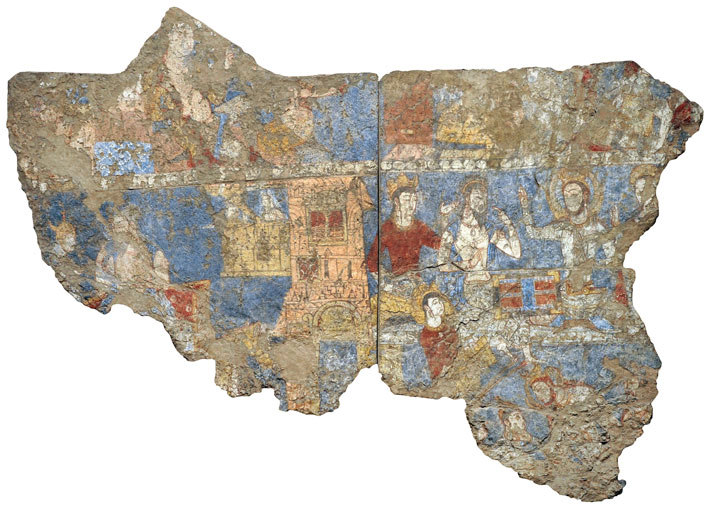
Both Mazdean temples contained remains of religious murals, and the walls of one of the royal palaces were decorated with paintings depicting tulips and poppies, as well as one example showing a hunt. Another palace, erected by Devastich, contained scenes depicting political events. However, the most vivid and best-preserved murals at Panjakent are not in the palaces and temples, but in the homes of wealthy and middle-class residents. An estimated one-third of all houses excavated at Panjakent contain evidence of murals, from shattered fragments to massive, nearly complete works that tell multiple stories. “Because so much of the painting at Panjakent is narrative, it must tell whatever story is being depicted in a realistic, detailed manner,” says Lerner. “The elegance of the style in which these narratives are rendered—both epic and anecdotal—is characteristically Sogdian.”
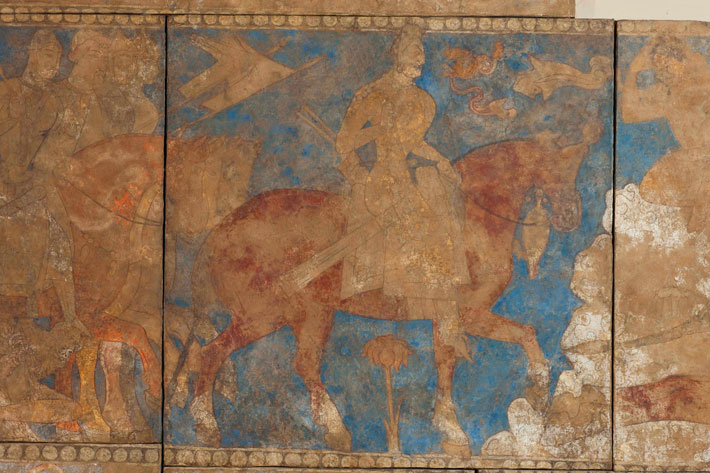
Sometimes the murals seem to reflect the personalities or occupations of those who commissioned them. In one house, where archaeologists found a number of bone gambling pieces, they also unearthed a mural depicting a scene from the Indian epic the Mahabharata, which shows the legendary king Virata playing backgammon, a game often associated with gambling. Another house, whose collection of unusually large granaries suggests its owner was a grain merchant, contained a mural depicting a harvest ceremony.
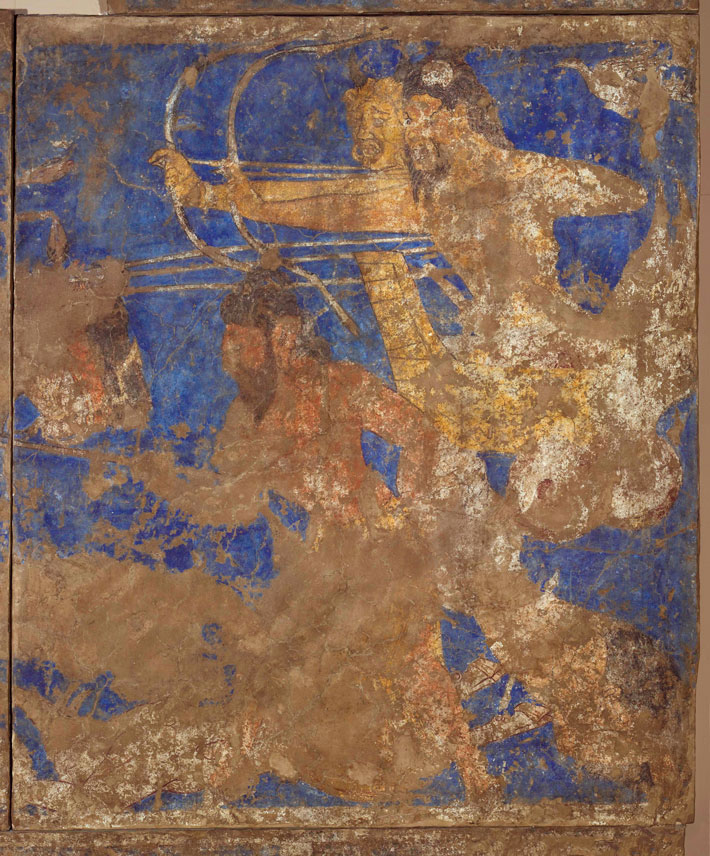
Perhaps the most spectacular mural was excavated at a midsize house in the southeastern section of the city. There, archaeologists discovered what they dubbed the Blue Hall, a banquet space with built-in benches along the walls. The surfaces of these walls were covered with intricate, 15-foot-high murals divided into horizontal sections. A top section depicts a religious ceremony, perhaps a family ritual. The middle and largest section shows scenes from the national epic of Iranian peoples, the Shahnameh, or “Book of Kings,” which was first written down around the year 1000, almost 300 years after the mural was painted. The mural depicts the feats of the hero Rustam as he leads an army to battle demons. Below the stories of Rustam is a smaller set of murals that illustrate a series of animal fables, which were popular in Panjakent. A mural discovered in another house even depicts the tale of the “Goose Who Laid the Golden Egg,” famous in the West from Aesop’s Fables. What remains of the Sogdians’ written culture is mostly religious and administrative in nature. But they surely had a rich literature as well, which may be partly reflected in these murals. “We know they had books,” says Lerner. “There’s a mid-eighth-century painting from Panjakent of a large illustrated codex. It’s possible that the tales and fables we see painted in the lower registers of the banquet rooms in Panjakent’s houses were also written and illustrated in bound or folded books.” Some of the scenes may reflect oral traditions, perhaps ones that Sogdians could tell while feasting and looking at the murals. Other stories may have reached Panjakent on painted scrolls.
The Blue Hall and some of the other rooms that contain brilliant murals date to the 740s, almost 20 years after the city was taken by Arab forces, who maintained a garrison there after dethroning Devastich. That Panjakenters felt comfortable enough at this time to commission large murals for their homes celebrating Sogdian religious rites and illustrating an epic central to their national identity suggests Arab rule was, at least initially, not particularly strict. It is unclear whether the Mazdean temples were used after the Arab invasion. The discovery in 2018 of a third building that may also have been a temple could give Lurje and his team a chance to investigate whether Sogdian religious ceremonies continued.
There are, however, signs that many houses in the city were renovated after the 722 Arab takeover, and the presence of murals dating to after this point suggests there was some kind of renaissance in Sogdian culture. It’s possible that wealthy Sogdians from larger cities such as Samarkand came to Panjakent and commissioned these paintings. But the city’s recovery was short-lived. “There is evidence that some murals were intentionally defaced, perhaps for religious reasons,” says Lurje. By 770, it seems much of central Panjakent was abandoned. It is possible that most of the descendants of the Sogdians who had lived in Panjakent moved a mile south to a site where the modern city of Panjakent now stands. By that time, almost all Sogdians had converted to Islam, and Sogdian culture was disappearing.
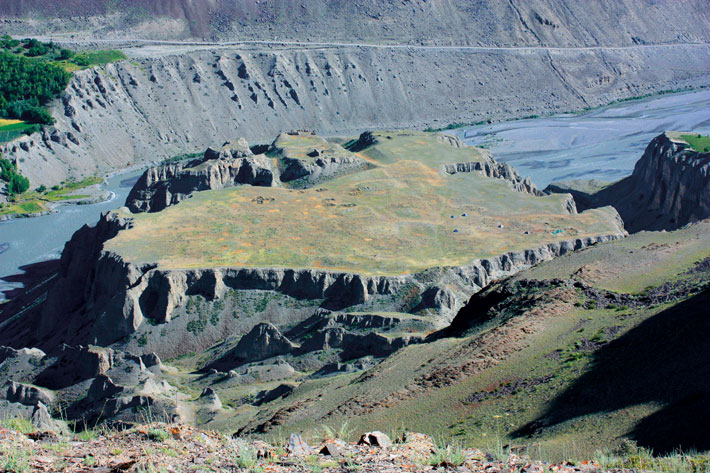
While excavating at Panjakent, Lurje and his team have also worked more than 100 miles upriver, at the site of Hisorak, which he has identified as Martshkat, a small Sogdian city mentioned at least seven times in the Mount Mugh archive. Since 2010, he has led excavations at Martshkat, which consisted of a settlement perched above a river gorge and attached to three mudbrick citadels. While some of the city’s buildings were decorated with murals, only fragmentary traces remain. Instead, the unusual chemistry of the soil has preserved other types of artifacts, especially goat and sheep skins. According to the Mount Mugh documents, the city was well known for producing leather from such hides. One document even mentions the name of the attendant, Wakhshmareg, who was responsible for the large basin used to tan the skins. Lurje believes he has identified this very basin in a large courtyard in the settlement. He has also unearthed several fragments of Sogdian writing preserved on sticks of wood. People were living at Martshkat as early as the first century A.D., but it appears the settlement expanded around the beginning of the eighth century, when the Arabs began to take power in Central Asia. Indeed, one of the Mount Mugh documents that mentions the city comes from an unnamed ruler asking for aid in recapturing workers who had absconded while building an important structure in the town. Lurje speculates that these men were working on one of the citadels, possibly in anticipation of a siege by Arab forces.

That siege appears never to have taken place, and people continued to live in Martshkat in reduced numbers until perhaps the tenth century, but it’s difficult to say exactly for how long. While some 3,000 coins have been unearthed at Panjakent, only three have been found at Martshkat, a sign perhaps that this city was at a remove from the bustling Silk Road economies that characterized Sogdian settlements in the Zeravshan Valley and the oases beyond.
By the time Martshkat was abandoned, it was likely one of the last outposts of Sogdian culture. Though the Sogdians were largely forgotten until recently, some of their words have made their way into modern languages. Such was the influence of Sogdian on the world of medieval commerce that the English word “check,” as in a bill, comes from the Sogdian term for invoice.
A remnant of Sogdian culture also lives on in the Yaghnob Valley in the mountains of northern Tajikistan. There, some 1,500 villagers of the Yaghnobi ethnicity still speak a language that is a descendant of a dialect related to literary Sogdian. During the 1970s, the Yaghnobi were forced from the mountains and compelled to live in the plains below. Eventually, the Yaghnobi were allowed to return to their villages, where Lurje visited them in 2008 and made recordings of their fairy tales. “In the nineteenth century, when the language was first set down by researchers, they said it would go extinct soon,” says Lurje. “They said the same thing in the twentieth century, and again in this century. But I wouldn’t be so sure.” He notes that the fairy tales the Yaghnobi tell are the same as those told by neighboring Tajik peoples, but he did notice one particular feature of their language. Yaghnobi speakers, he says, are fond of inventing humorous slang and playing word games with each other to a degree Lurje has never encountered among other speakers of Iranian languages. It’s tempting to imagine their ancestors relishing the same sort of wordplay as they sat and conversed in their muraled halls, or as they whiled away the hours as their caravans wended along the Sogdian Road.
Slideshow: Murals of the Silk Road
The Sogdians of Central Asia were the master traders of the Silk Road from the fifth to eighth century A.D. Their wealth enabled Sogdians from the highest nobles to members of the middle class to commission lavish murals that adorned temples, palaces, and modest homes alike. At the Sogdian city of Panjakent in modern-day Tajikistan, archaeologists have unearthed murals that depict deities, fables, and military campaigns of the day. The following images of murals from Panjakent are © The State Hermitage Museum. To see the Smithsonian’s comprehensive online exhibit on the Sogdians, go to: “The Sogdians: Influencers on the Silk Road.”


